|
|
Sa Pa Town
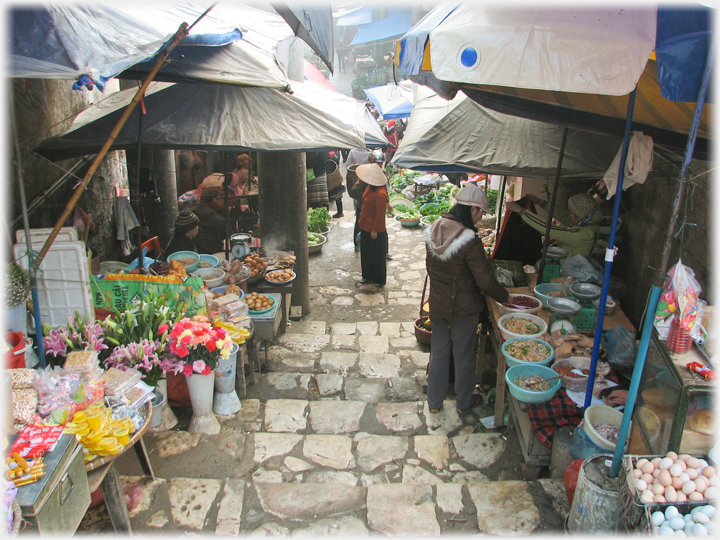 The steep hillsides on which Sa Pa sits, add an extra dimension to its street markets
Sa Pa lies on the border with China in north-west Vietnam at a height of 1,600 m (5,000 ft). During their occupation in the 1880s the French developed it as a cool retreat from the heat of the valleys and plains below, and it also provided an important buffer for the newly established border with China.
The steep hillsides on which Sa Pa sits, add an extra dimension to its street markets
Sa Pa lies on the border with China in north-west Vietnam at a height of 1,600 m (5,000 ft). During their occupation in the 1880s the French developed it as a cool retreat from the heat of the valleys and plains below, and it also provided an important buffer for the newly established border with China.
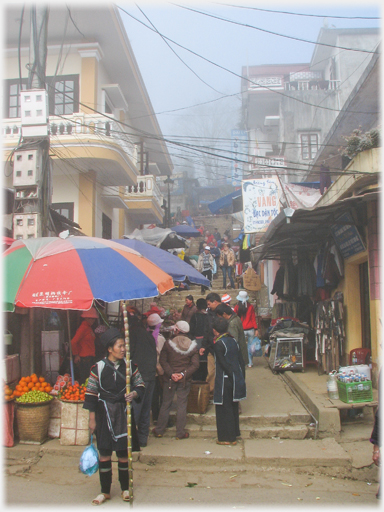 Morning mist clearing from a Sa Pa street
Morning mist clearing from a Sa Pa street
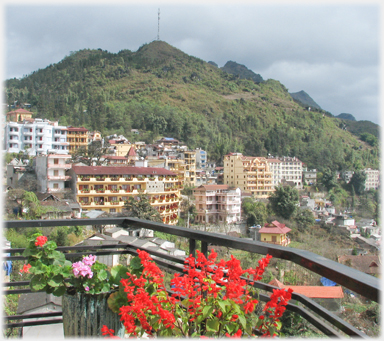 Many large hotels now line the hillsides with fine views...
Many large hotels now line the hillsides with fine views...
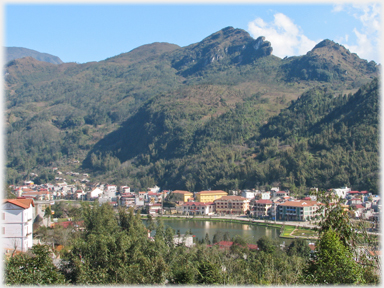 ...while others nestle in the shelter of the hills
...while others nestle in the shelter of the hills
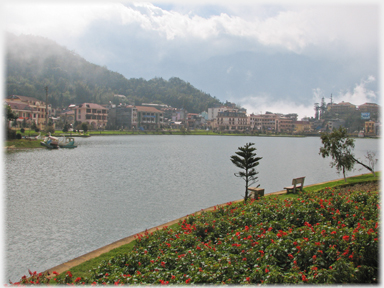 Sa Pa Lake near the town centre
Sa Pa Lake near the town centre
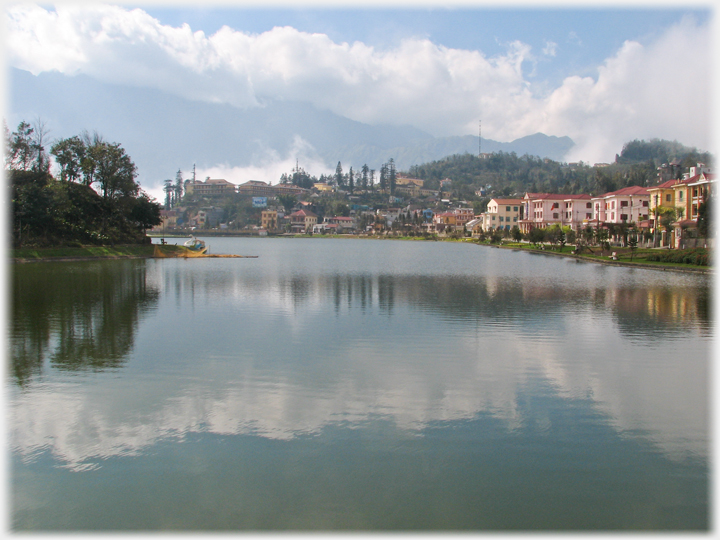 The Lake in Sa Pa with its line of grand villas originally built for the French, although nearly all destroyed by the French war of the 50s, and then the Chinese invasion of the 70s, but now rebuilt
The Lake in Sa Pa with its line of grand villas originally built for the French, although nearly all destroyed by the French war of the 50s, and then the Chinese invasion of the 70s, but now rebuilt
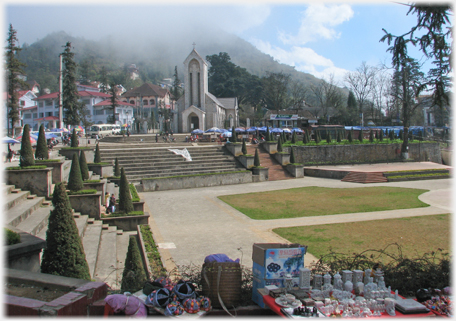 The central square with the Catholic church which dates from 1930
The central square with the Catholic church which dates from 1930
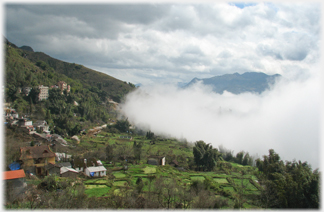 Evening mist creeping up to the town
Sa Pa's growth since the middle of the last century has been rapid, and it is now one of the two main tourist destinations outside Hà Nội. Sadly it follows that it is one of the only places in northern Vietnam where the local people take too much interest in tourists.
Evening mist creeping up to the town
Sa Pa's growth since the middle of the last century has been rapid, and it is now one of the two main tourist destinations outside Hà Nội. Sadly it follows that it is one of the only places in northern Vietnam where the local people take too much interest in tourists.
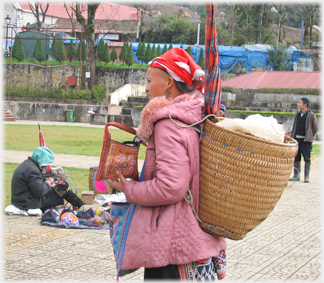 One of the woven panniers seen in many parts of northern Vietnam
One of the woven panniers seen in many parts of northern Vietnam
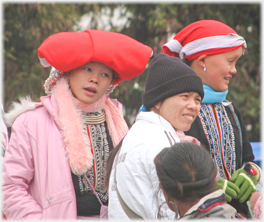 Red Dao women in their best hats
Red Dao women in their best hats
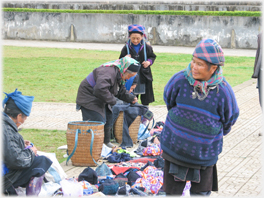 Black Hmong vendors laying out their goods in the central square
Black Hmong vendors laying out their goods in the central square
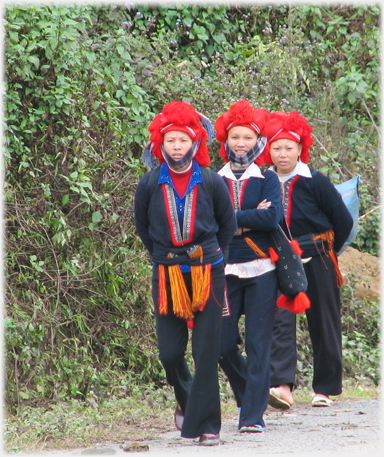 Three Red Dao women walking to the Sa Pa market
Three Red Dao women walking to the Sa Pa market
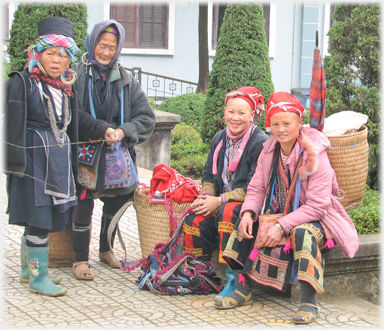 The staple trade of the town is selling a range of embroidery to tourists
The staple trade of the town is selling a range of embroidery to tourists
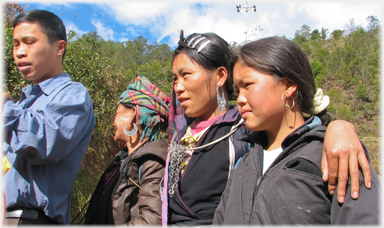 Black Hmong with some examples of the jewellery worn
One of the main tourist attractions Sa Pa has is its diversity of ethnic groups. The largest of these groups are the Hmong people who account for just over 50% of the population, the Vietnamese (or Kinh) are less than a quarter mostly having arrived in the last 40 years. The other major group are the Dao (pronounced zow).
Black Hmong with some examples of the jewellery worn
One of the main tourist attractions Sa Pa has is its diversity of ethnic groups. The largest of these groups are the Hmong people who account for just over 50% of the population, the Vietnamese (or Kinh) are less than a quarter mostly having arrived in the last 40 years. The other major group are the Dao (pronounced zow).
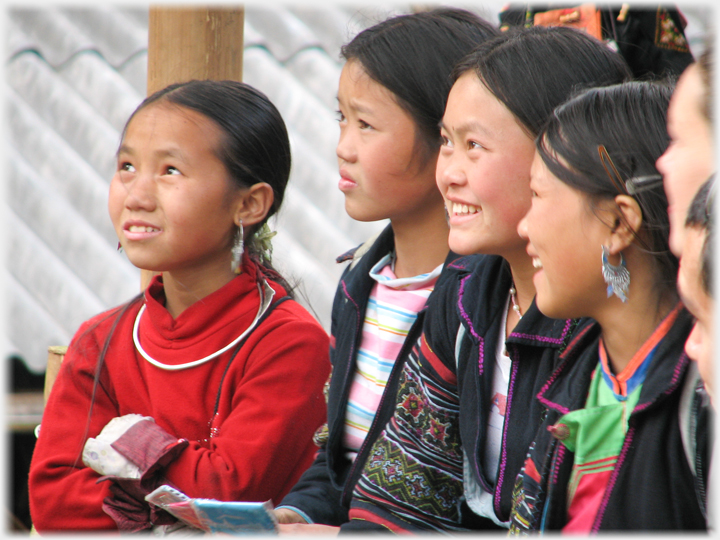 Black Hmong girls being entertained
Black Hmong girls being entertained
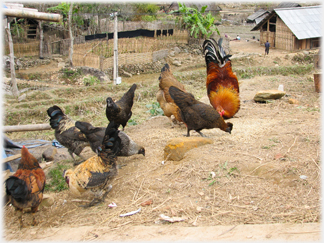 Hens with house and compound beyond
Hens with house and compound beyond
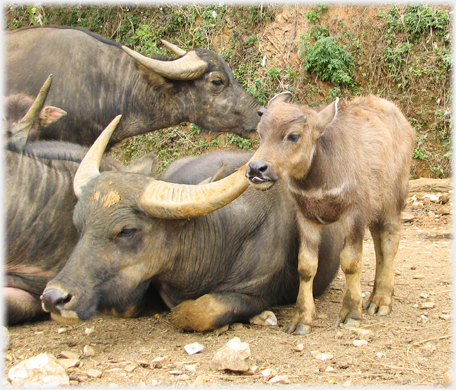 Buffalo and calf
The domestic animals catch visitors attention, most especially the buffalo with their gentle eyes and calm disposition
Buffalo and calf
The domestic animals catch visitors attention, most especially the buffalo with their gentle eyes and calm disposition
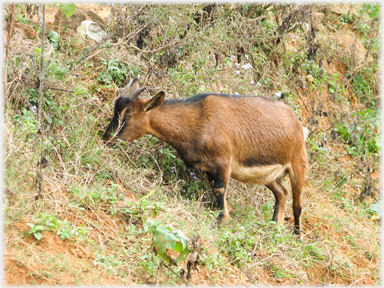 Domestic goats graze with some freedom on the hillsides
Domestic goats graze with some freedom on the hillsides
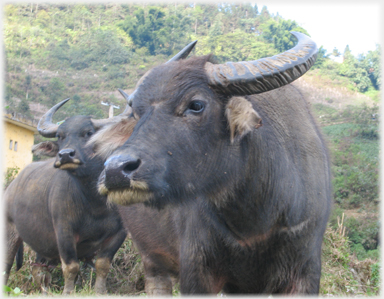 Doe eyed Buffalo with the soft ear hair that looks like feathers; in Vietnamese animal hair and birds feathers have the same word
Doe eyed Buffalo with the soft ear hair that looks like feathers; in Vietnamese animal hair and birds feathers have the same word
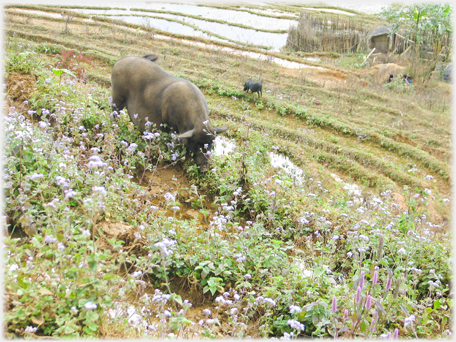 Pigs are left to root along the fallow terraces
Pigs are left to root along the fallow terraces
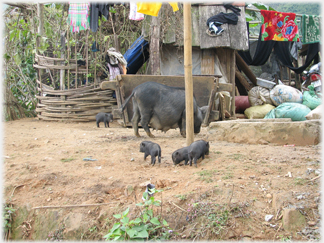 A sow and her piglets beside a house
A sow and her piglets beside a house
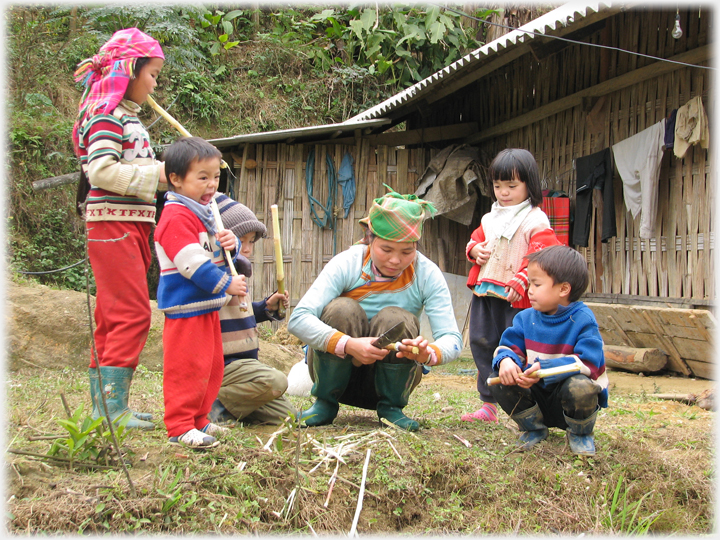 Children eagerly receiving a sweet treat - sticks of sugarcane
The next page
goes to the approach to the Mã Pì Lèng Pass - some 200 km to the north-east of Sa Pa
Children eagerly receiving a sweet treat - sticks of sugarcane
The next page
goes to the approach to the Mã Pì Lèng Pass - some 200 km to the north-east of Sa Pa
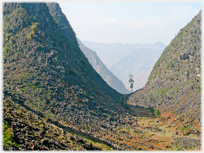

Saturday 20th August 2016

Go to the Picture Posting contents page
Return to the top
|
|
 The steep hillsides on which Sa Pa sits, add an extra dimension to its street markets
Sa Pa lies on the border with China in north-west Vietnam at a height of 1,600 m (5,000 ft). During their occupation in the 1880s the French developed it as a cool retreat from the heat of the valleys and plains below, and it also provided an important buffer for the newly established border with China.
The steep hillsides on which Sa Pa sits, add an extra dimension to its street markets
Sa Pa lies on the border with China in north-west Vietnam at a height of 1,600 m (5,000 ft). During their occupation in the 1880s the French developed it as a cool retreat from the heat of the valleys and plains below, and it also provided an important buffer for the newly established border with China.
 Morning mist clearing from a Sa Pa street
Morning mist clearing from a Sa Pa street
 Many large hotels now line the hillsides with fine views...
Many large hotels now line the hillsides with fine views...
 ...while others nestle in the shelter of the hills
...while others nestle in the shelter of the hills
 Sa Pa Lake near the town centre
Sa Pa Lake near the town centre
 The Lake in Sa Pa with its line of grand villas originally built for the French, although nearly all destroyed by the French war of the 50s, and then the Chinese invasion of the 70s, but now rebuilt
The Lake in Sa Pa with its line of grand villas originally built for the French, although nearly all destroyed by the French war of the 50s, and then the Chinese invasion of the 70s, but now rebuilt
 The central square with the Catholic church which dates from 1930
The central square with the Catholic church which dates from 1930
 Evening mist creeping up to the town
Sa Pa's growth since the middle of the last century has been rapid, and it is now one of the two main tourist destinations outside Hà Nội. Sadly it follows that it is one of the only places in northern Vietnam where the local people take too much interest in tourists.
Evening mist creeping up to the town
Sa Pa's growth since the middle of the last century has been rapid, and it is now one of the two main tourist destinations outside Hà Nội. Sadly it follows that it is one of the only places in northern Vietnam where the local people take too much interest in tourists.
 One of the woven panniers seen in many parts of northern Vietnam
One of the woven panniers seen in many parts of northern Vietnam
 Red Dao women in their best hats
Red Dao women in their best hats
 Black Hmong vendors laying out their goods in the central square
Black Hmong vendors laying out their goods in the central square
 Three Red Dao women walking to the Sa Pa market
Three Red Dao women walking to the Sa Pa market
 The staple trade of the town is selling a range of embroidery to tourists
The staple trade of the town is selling a range of embroidery to tourists
 Black Hmong with some examples of the jewellery worn
One of the main tourist attractions Sa Pa has is its diversity of ethnic groups. The largest of these groups are the Hmong people who account for just over 50% of the population, the Vietnamese (or Kinh) are less than a quarter mostly having arrived in the last 40 years. The other major group are the Dao (pronounced zow).
Black Hmong with some examples of the jewellery worn
One of the main tourist attractions Sa Pa has is its diversity of ethnic groups. The largest of these groups are the Hmong people who account for just over 50% of the population, the Vietnamese (or Kinh) are less than a quarter mostly having arrived in the last 40 years. The other major group are the Dao (pronounced zow).
 Black Hmong girls being entertained
Black Hmong girls being entertained
 Hens with house and compound beyond
Hens with house and compound beyond
 Buffalo and calf
The domestic animals catch visitors attention, most especially the buffalo with their gentle eyes and calm disposition
Buffalo and calf
The domestic animals catch visitors attention, most especially the buffalo with their gentle eyes and calm disposition
 Domestic goats graze with some freedom on the hillsides
Domestic goats graze with some freedom on the hillsides
 Doe eyed Buffalo with the soft ear hair that looks like feathers; in Vietnamese animal hair and birds feathers have the same word
Doe eyed Buffalo with the soft ear hair that looks like feathers; in Vietnamese animal hair and birds feathers have the same word
 Pigs are left to root along the fallow terraces
Pigs are left to root along the fallow terraces
 A sow and her piglets beside a house
A sow and her piglets beside a house
 Children eagerly receiving a sweet treat - sticks of sugarcane
The next page
goes to the approach to the Mã Pì Lèng Pass - some 200 km to the north-east of Sa Pa
Children eagerly receiving a sweet treat - sticks of sugarcane
The next page
goes to the approach to the Mã Pì Lèng Pass - some 200 km to the north-east of Sa Pa


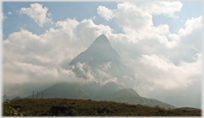 The last page was about the road between Sa Pa and Mount Phăng Xi Păng
The last page was about the road between Sa Pa and Mount Phăng Xi Păng
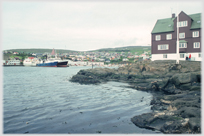 To a page on a very different town by water - Tórshavn in the Faroes
To a page on a very different town by water - Tórshavn in the Faroes
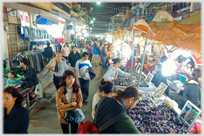 Another Vietnamese market - the Hà Nội night market
Another Vietnamese market - the Hà Nội night market
